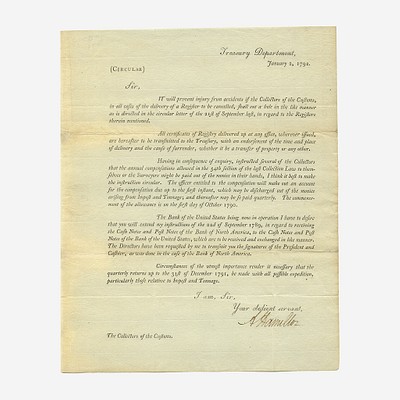[Hamilton, Alexander] [American Revolution] Table of the First Year's Interest To be paid on Monies which have been placed in the several Continental
About Seller
2400 Market St
Philadelphia, PA 19147
United States
Established in 1805, Freeman’s Auction House holds tradition close, with a progressive mind-set towards marketing and promotion, along with access to a team of top experts in the auction business. And now with offices in New England, the Southeast, and on the West Coast, it has never been easier to ...Read more
Two ways to bid:
- Leave a max absentee bid and the platform will bid on your behalf up to your maximum bid during the live auction.
- Bid live during the auction and your bids will be submitted real-time to the auctioneer.
Bid Increments
| Price | Bid Increment |
|---|---|
| $0 | $25 |
| $500 | $50 |
| $1,000 | $100 |
| $2,000 | $200 |
| $3,000 | $250 |
| $5,000 | $500 |
| $10,000 | $1,000 |
| $20,000 | $2,000 |
| $30,000 | $2,500 |
| $50,000 | $5,000 |
| $100,000 | $10,000 |
About Auction
Oct 25, 2021
Freeman's is honored to present The Alexander Hamilton Collection of John E. Herzog, a single-owner sale of Alexander Hamilton material, on October 25. Curated by Darren Winston, Head of the Books and Manuscripts Department. Freeman's info@freemansauction.com
- Lot Description
[Hamilton, Alexander] [American Revolution] Table of the First Year's Interest To be paid on Monies which have been placed in the several Continental Loan-Offices...
A rare glimpse at how the American Revolution was financed
(Philadelphia: David C. Claypool, 1779). 8vo. 7 pp. An extremely rare imprint of statistical calculation of Continental currency circulation via the several Continental loan offices, being a "Table of the First Year's Interest...To be paid on Monies which have been placed in the several Continental Loan-Offices, between the 1st of June and 1st of December 1778, calculated for each day on which Money may have been lent, in Pursuance of a Resolution of Congress of the 29th of June, 1779..." Contemporary stiff paper wrappers; inscription on front wrapper: "A Table/of Interest on/Loan Office/Certificates/January 1780"; faint dampstaining to text leaves; scattered ink spotting to text. Evans 16634; ESTC W2116, locates two copies; Ford 230; NAIP locates one copy
The Continental Loan-Office was established in 1776 to administer loans to the Continental Treasury to help finance the war effort. These offices issued interest-bearing bonds to investors, while also selling bills of exchange and performing other financial duties on behalf of the government. Bonds offered were signed by first United States Treasurer Michael Hillegas or his son, Samuel, and then sent to state loan offices to be sold to investors at variable interest rates. This pamphlet records the aggregate amount of money in circulation in several loan offices for each day from June-December for the years 1778 and 1779, with the interest of the sums calculated on $100, and in denominations of "dol., 90ths., parts." Between 1778-1781 the sale of loan certificates had raised an estimated sixty million dollars for the war, at least according the Congressional calculations. Printed by order of the Board of Treasury, and signed in type by secretary Robert Troup.
Financing the American Revolution was a persistent problem for the duration of the war. Without the means to properly levy taxes in the states, and with no established credit, the Continental Congress had to resort to an ever-shifting scheme of printing money, issuing bills of credit, impressing supplies and services, and offering bonds, to help sustain the war. By the war's end the domestic debt reached over $40 million, and with little power under the Articles of Confederation to meet its obligations, the financial situation in the new nation rapidly deteriorated. With the ratification of the Constitution in 1788, the establishment of the Treasury Department in 1789, and under the direction of its first Secretary Alexander Hamilton, the debts incurred domestically were finally brought under control under the Federal government through its ability to tax.
- Shipping Info
-
No lot may be removed from Freeman’s premises until the buyer has paid in full the purchase price therefor including Buyer’s Premium or has satisfied such terms that Freeman’s, in its sole discretion, shall require. Subject to the foregoing, all Property shall be paid for and removed by the buyer at his/ her expense within ten (10) days of sale and, if not so removed, may be sold by Freeman’s, or sent by Freeman’s to a third-party storage facility, at the sole risk and charge of the buyer(s), and Freeman’s may prohibit the buyer from participating, directly or indirectly, as a bidder or buyer in any future sale or sales. In addition to other remedies available to Freeman’s by law, Freeman’s reserves the right to impose a late charge of 1.5% per month of the total purchase price on any balance remaining ten (10) days after the day of sale. If Property is not removed by the buyer within ten (10) days, a handling charge of 2% of the total purchase price per month from the tenth day after the sale until removal by the buyer shall be payable to Freeman’s by the buyer. Freeman’s will not be responsible for any loss, damage, theft, or otherwise responsible for any goods left in Freeman’s possession after ten (10) days. If the foregoing conditions or any applicable provisions of law are not complied with, in addition to other remedies available to Freeman’s and the Consignor (including without limitation the right to hold the buyer(s) liable for the bid price) Freeman’s, at its option, may either cancel the sale, retaining as liquidated damages all payments made by the buyer(s), or resell the property. In such event, the buyer(s) shall remain liable for any deficiency in the original purchase price and will also be responsible for all costs, including warehousing, the expense of the ultimate sale, and Freeman’s commission at its regular rates together with all related and incidental charges, including legal fees. Payment is a precondition to removal. Payment shall be by cash, certified check or similar bank draft, or any other method approved by Freeman’s. Checks will not be deemed to constitute payment until cleared. Any exceptions must be made upon Freeman’s written approval of credit prior to sale. In addition, a defaulting buyer will be deemed to have granted and assigned to Freeman’s, a continuing security interest of first priority in any property or money of, or owing to such buyer in Freeman’ possession, and Freeman’s may retain and apply such property or money as collateral security for the obligations due to Freeman’s. Freeman’s shall have all of the rights accorded a secured party under the Pennsylvania Uniform Commercial Code.
-
- Buyer's Premium



 EUR
EUR CAD
CAD AUD
AUD GBP
GBP MXN
MXN HKD
HKD CNY
CNY MYR
MYR SEK
SEK SGD
SGD CHF
CHF THB
THB![[Hamilton, Alexander] [American Revolution] Table of the First Year's Interest To be paid on Monies which have been placed in the several Continental](https://s1.img.bidsquare.com/item/l/9470/9470993.jpeg?t=1MwoEU)
![[Hamilton, Alexander] [American Revolution] Table of the First Year's Interest To be paid on Monies which have been placed in the several Continental](https://s1.img.bidsquare.com/item/s/9470/9470993.jpeg?t=1MwoEU)










